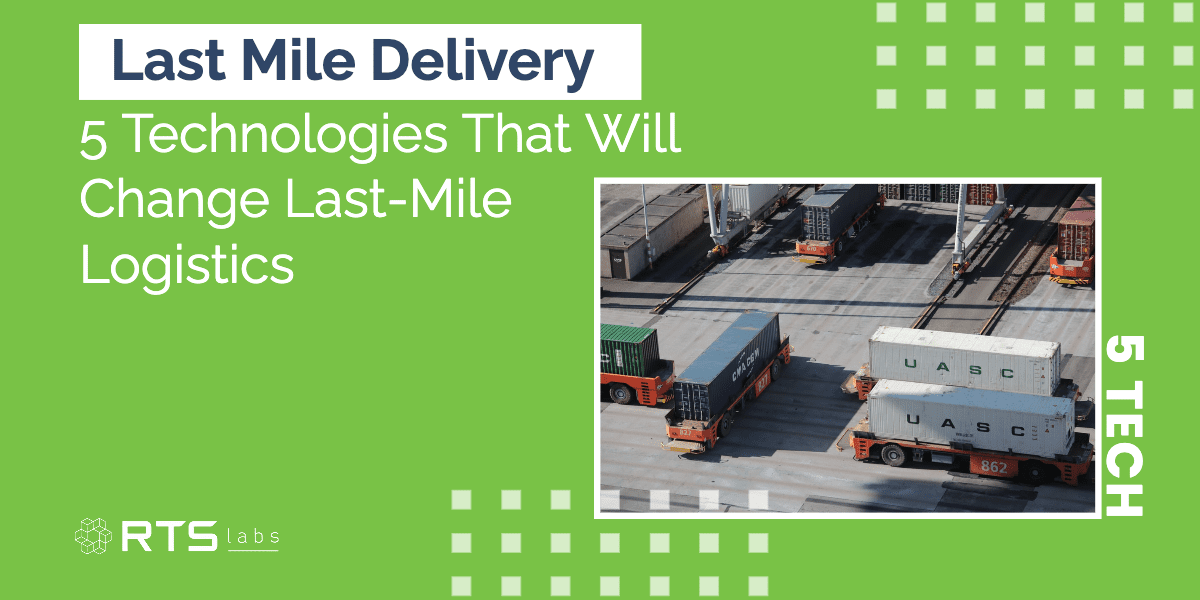The last mile looks a lot different in Anaheim than it does in Anchorage. People around the world have increasingly come to rely on eCommerce retailers and free super-fast shipping to stock up on every product under the sun — particularly in an age of pandemics and social distancing. Anaheim’s logistics might be a lot easier to manage than Anchorage’s, but customers in both locations nonetheless expect vast product options and fast delivery.
Maintaining high standards of shipping speed and quality across nearly 4 million square miles in the United States (not to mention the millions and millions of square miles everywhere else) requires more than manpower and vehicular fortitude. Modern logistics requires modern technology. There are many competing hardware and software solutions in today’s last-mile bottlenecks, but some technologies simply matter more than others to the future of last-mile logistics.
Let’s take a look at 5 of the most essential next-gen last-mile technologies on the market today…
On-demand delivery service platforms
If you’ve ordered from Instacart, Uber Eats, Postmates, or any number of other store-to-door delivery services, you’ve probably engaged with on-demand delivery platforms.
These new, semi-decentralized delivery operations rely on large pools of contract-based or trip-based delivery drivers to get your products from the nearest warehouse or retail store to your front door. By tapping into much larger talent pools, typically working flexible hours and utilizing their own vehicles, on-demand crowdsourced delivery platforms can drastically reduce their overhead while improving responsiveness in the last mile.
Decentralized delivery platforms have been a boon to non-traditional eCommerce operations, particularly in restaurant and grocery delivery, which boomed in 2020 as shelter-in-place mandates kept most folks from venturing out to their favorite eateries or supermarkets. Even Amazon has shifted to crowdsourced delivery in recent years, as you may have noticed when an Amazon-branded Sprinter van makes its way through your neighborhood to deliver packages.
AI route planning
UPS doesn’t take left turns (unless they have to). The company discovered years ago that it was more fuel- and time-efficient to route its drivers along three consecutive right turns than it would’ve been to have them wait for a clear chance to turn left at an intersection.
This seemingly simple discovery saves UPS 10 million gallons of fuel every year and allows them to deliver 350,000 more packages despite running 1,000 fewer delivery trucks on local streets than it did before the left-turn discovery.
Big companies save millions through AI-optimized route planning, but the technology has been a boon to crowdsourced delivery services as well. Google Maps, with its real-time traffic updates and route planning options, which allow drivers to skip tolls, busy highways, and congested roads, is an essential app on any decentralized delivery contractor’s phone in 2021.
Many apps go a step further with route-planning technology of their own — at times, with mixed results. Anyone who’s taken an Uber that didn’t seem as efficient as it could’ve been can probably blame Uber’s insistence on using in-house route planning rather than Google Maps.
Blockchain, IoT, and other smart tracking tech
Where is your package right now? Where has it been? A few years ago, you had two options when it came to tracking the movement of your eCommerce orders through the delivery chain: you might get an update when your package left the warehouse, and you might be notified when it was dropped off at your door.
Today, smart tracking technologies can give you real-time map visibility on the current location of your orders. That notification letting you know “your package is 10 stops away” always gives me a little jolt and gets me to watch my front door like a hawk. It’s fun, engaging, and makes for great customer service when you can see exactly where your stuff is and can anticipate its arrival down to the minute.
Most of this real-time tracking is currently managed by a combination of Internet of Things technology and RFID tags, but blockchain-based tracking is becoming increasingly popular. Blockchain tracking adds an extra layer of transparency to logistics networks, as the movement of goods and orders can be tracked, recorded, and updated at every point of transfer, and along every movement through the supply chain.
Not only does this provide greater visibility into order movement, it also adds security to the supply chain, by allowing companies to track problems back to their source — by, for example, identifying a bad batch of gizmos, or a contaminated shipment of meat, and recalling these defective goods before they cause harm to end-users.
Autonomous delivery by land or air
Have you ever gotten a package from a robot? You will soon enough, thanks to any number of startups and established companies working hard to address the challenges of robotic home delivery. Some companies focus on autonomous cars, carts, or other wheeled vehicles. Some companies (including Amazon) are pouring resources into drone-based deliveries.
Autonomous vehicles offer many of the upsides mentioned earlier — on-demand delivery, AI-optimized route planning, and real-time tracking capabilities — without the drawbacks of human drivers, who can be forgetful, take wrong turns, miss stops, or simply need to handle urgent biological needs before dropping off a package.
Autonomous deliveries are still in the prototype phase, but so much money and talent has been poured into this technology that it’d be surprising if we didn’t get most of our eCommerce orders delivered by robots by the end of the decade.
Connected homes
The last step of the last mile ends at your front door. If you live in a populated area, spend a lot of time away from home, or simply don’t want to risk weather damage (or other harms) to your packages, you might want to consider investing in connected home technology.
Connected doorbells will let you know when your package has arrived and can tell you if someone shady is snooping around for free stuff on your front porch.
Some connected home tech even allows you to grant temporary access to your delivery person, ensuring your package stays safe inside — provided you trust the driver at any rate. There are also other less-risky connected-home technologies, like connected mailboxes, or certain new cars that can remotely unlock their trunks for easy secure drop-off. Just pop the mailbox or the trunk remotely and get your stuff secured without giving anyone access to your inner sanctum.
It’s not far-fetched to think that someday, an unmanned delivery drone or autonomous vehicle will pull up to your driveway to drop your package off in a smart mailbox, in just hours after you’ve placed your order. In some places, it’s already becoming a reality.
Is your company ready for this new world of last-mile logistics? RTS has decades of collective experience in implementing and optimizing supply chain technology for some of the world’s largest logistics companies, and we’d love to help you, too. Want to learn more? Get in touch with us today!






